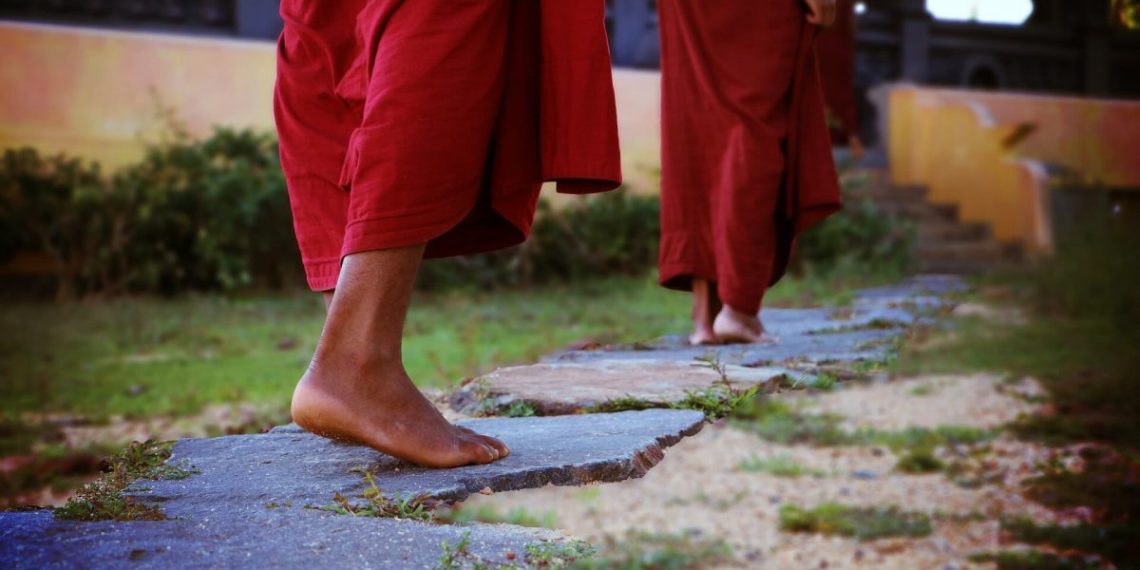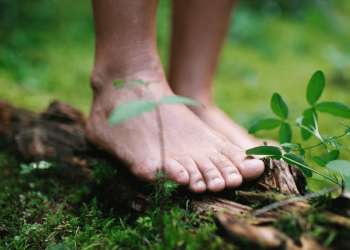Walking meditation is an ancient contemplative practice that transforms one of our most basic activities into a powerful tool for cultivating mindfulness, awareness, and inner peace. Unlike seated meditation, which emphasizes stillness, walking meditation integrates movement with meditative awareness, making it particularly accessible for those who find sitting meditation challenging or who want to bring mindfulness into daily life.
This practice has roots in Buddhist traditions, where monks have walked mindfully for thousands of years, but it has since evolved into secular forms practiced worldwide. Walking meditation bridges the gap between formal meditation practice and everyday life, teaching us to bring present-moment awareness to all our activities.
Benefits of Walking Meditation
Before diving into techniques, understanding the benefits can deepen your motivation and practice:
Physical Benefits: Walking meditation improves balance, coordination, and body awareness. It’s gentler on the body than seated meditation for those with back pain or limited mobility. The natural movement also helps release physical tension and improves circulation.
Mental Benefits: This practice reduces anxiety and racing thoughts by anchoring attention to the physical sensations of walking. It cultivates concentration while maintaining alertness, making it particularly useful for those who become drowsy during seated meditation.
Emotional Benefits: Walking meditation creates space between stimulus and response, helping you develop emotional regulation. The rhythmic nature of walking can be naturally calming and grounding.
Practical Benefits: You can practice anywhere—in your home, garden, park, or even in urban environments. It integrates seamlessly into daily life, transforming routine walks into meditation sessions.
Basic Techniques
Standard Walking Meditation
This foundational technique forms the basis for all other practices.
Setup: Find a quiet path of 20-30 feet where you can walk back and forth without obstacles. Stand at one end with feet hip-width apart, arms relaxed at your sides or hands clasped gently in front or behind you.
Practice:
- Stand still for a moment, feeling your body’s weight distributed through your feet
- Begin walking at a natural, slightly slower than normal pace
- Focus your attention on the physical sensations in your feet and legs—the lifting, moving, and placing of each foot
- Notice the shifting of weight, the contact with the ground, the movement of muscles
- When you reach the end of your path, pause briefly, then turn mindfully and continue
- If your mind wanders, gently return attention to the sensations of walking
- Practice for 10-20 minutes initially, gradually extending the duration
Key Points: Maintain soft, downward-focused eyes, looking a few feet ahead. Breathe naturally. The goal isn’t to reach a destination but to be fully present with each step.
Breath-Coordinated Walking
This technique synchronizes steps with breathing, creating a harmonious rhythm.
Practice:
- Begin walking at a comfortable pace
- Notice your natural breathing rhythm
- Coordinate your steps with your breath—for example, three steps per inhale, three steps per exhale
- You might mentally note “in, in, in” with each step during inhalation and “out, out, out” during exhalation
- Adjust the number of steps to match your natural breath—don’t force the breath to fit arbitrary steps
- Allow the coordination to feel natural and effortless
This technique is excellent for calming the nervous system and is particularly helpful during stressful periods.
Body Scan Walking
This expands awareness beyond the feet to include the entire body.
Practice:
- Start with awareness in your feet for a few minutes
- Gradually expand attention to include your ankles, then calves, then knees
- Continue expanding awareness up through thighs, hips, abdomen, chest, arms, shoulders, neck, and head
- Maintain awareness of your whole body walking, feeling it as a unified, moving system
- Notice areas of tension or holding and allow them to soften
- Return to full-body awareness whenever attention narrows
This technique develops comprehensive body awareness and helps release unconscious tension.
Intermediate Techniques
Slow Motion Walking
This practice dramatically slows movement to microscopic levels, revealing the complexity of walking.
Practice:
- Stand still and establish your intention
- Begin lifting one foot with excruciating slowness, taking 30-60 seconds to complete one step
- Break down each step into distinct phases: lifting, moving, placing, shifting weight
- Notice the intricate muscle movements, balance adjustments, and sensory details
- Maintain unwavering attention throughout each micro-movement
- Continue for 15-20 minutes, though you may only travel a few feet
Applications: This powerful concentration practice reveals how much we normally miss in our experience. It’s particularly effective for developing penetrating awareness and patience.
Noting Practice
This technique uses mental labels to maintain precise awareness.
Practice:
- As you walk, make brief mental notes of your primary experience
- For foot sensations: “lifting, moving, placing, touching”
- When sounds arise: note “hearing”
- For thoughts: note “thinking”
- For emotions: note “feeling”
- Return to noting the physical sensations of walking
- Keep notes brief, crisp, and non-judgmental
This method trains the mind to recognize experience clearly without getting lost in content.
Sensory Channels Walking
This practice rotates attention through different sense experiences.
Practice:
- Walk for 2-3 minutes focusing exclusively on physical sensations (touch, pressure, movement)
- Shift attention to sounds for 2-3 minutes—near and far, subtle and obvious
- Move to visual experiences—colors, shapes, light, shadow—while maintaining peripheral awareness of walking
- Notice smells and air quality for 2-3 minutes
- Observe tastes or mouth sensations
- Rotate through all senses or choose two to alternate between
This develops flexibility of attention and reveals the richness of sensory experience.
Advanced Techniques
Choiceless Awareness Walking
This open monitoring practice releases directed attention, allowing awareness to rest naturally.
Practice:
- Begin with a few minutes of basic walking meditation to establish presence
- Gradually release focused attention on any particular object
- Allow awareness to receive whatever arises—sounds, sensations, thoughts, emotions—without selecting or rejecting
- Maintain awareness of walking, but don’t narrow attention to it
- Rest in spacious, open awareness while the body walks
- When you notice you’ve become absorbed in thought, gently return to open presence
This practice cultivates effortless awareness and insight into the nature of experience itself.
Contemplative Inquiry Walking
This technique combines walking with investigating fundamental questions.
Practice:
- Choose a contemplative question: “What am I?” “What is awareness?” “What is this moment?”
- Begin walking with the question held lightly in awareness
- Don’t try to think through or answer the question intellectually
- Allow the question to resonate while maintaining sensory presence
- Notice what arises—insights, feelings, or deeper questions
- Maintain both the inquiry and embodied awareness simultaneously
This advanced practice develops insight wisdom and non-conceptual understanding.
Environmental Integration Walking
This practice dissolves the boundary between self and environment.
Practice:
- Walk in a natural setting—forest, beach, park, or garden
- Begin with body awareness, then expand to include your immediate surroundings
- Notice your experience as part of the environment, not separate from it
- Feel the wind as part of your experience, not something happening “to you”
- Sense yourself as the environment experiencing itself
- Allow the sense of a separate walker to soften or dissolve
This practice cultivates non-dual awareness and deep ecological connection.
Loving-Kindness Walking
This heart-centered practice combines walking with metta (loving-kindness) meditation.
Practice:
- Begin walking with body awareness
- Silently repeat phrases like “May I be happy, may I be peaceful, may I be safe”
- After several minutes, extend wishes to others you pass or imagine
- “May you be happy, may you be peaceful, may you be safe”
- Continue walking while radiating goodwill
- Notice how this affects your body, emotions, and perception
This practice develops compassion while maintaining mindful movement.
Practical Applications
Daily Life Integration
Transform routine walks into practice opportunities. When walking to your car, between meetings, or through your home, bring meditative awareness to these movements. Start with just one walk per day—perhaps your morning commute or evening stroll—and commit to making it a meditation session.
Transition Tool
Use brief walking meditation as a transition between activities. After a stressful meeting, walk mindfully for five minutes before your next task. This creates psychological space and prevents stress accumulation.
Problem-Solving Aid
When stuck on a problem, try walking meditation without trying to solve anything. The combination of movement and present-moment awareness often allows insights to arise naturally.
Exercise Enhancement
Begin or end exercise sessions with walking meditation. This creates mindful bookends and helps you transition into and out of more vigorous activity with greater awareness.
Urban Practice
Walking meditation works in cities too. Use crosswalks, hallways, or short distances between destinations. The bustle becomes part of the practice, teaching you to maintain presence amid distraction.
Tips for Deepening Your Practice
Start Where You Are: Begin with whatever technique feels accessible. Even five minutes of basic walking meditation provides benefits.
Consistency Matters More Than Duration: Daily practice for 10 minutes builds the habit better than sporadic hour-long sessions.
Adjust for Conditions: In cold weather, walk faster. When agitated, slow down. Adapt the practice to serve your current state.
Indoor and Outdoor: Practice both. Indoor walking in a dedicated space supports concentration. Outdoor walking develops adaptability and appreciation.
Remove Distractions: Leave your phone behind or put it on airplane mode. This time is for presence, not productivity.
Be Patient: Some days the mind will be calm, other days scattered. Both are part of the practice. Your job is to show up, not to achieve a particular state.
Combine with Sitting: Many practitioners alternate between walking and sitting meditation in the same session, using each to balance the other.
Conclusion
Walking meditation offers a profound yet accessible path to mindfulness and awakening. By bringing meditative awareness to this simple, universal activity, you develop presence, concentration, and insight while engaging with life rather than withdrawing from it.
Start with the basic techniques and let your practice evolve naturally. Some days you’ll want slow, concentrated walking; other days, open awareness in nature. The beauty of walking meditation is its versatility—it meets you wherever you are and grows with you over time.
Remember that the goal isn’t perfect practice or special experiences. It’s simply to be fully alive and aware in each step, each moment. In this way, walking meditation transforms not just your walking, but your entire relationship with being alive.
As the Zen teacher Thich Nhat Hanh beautifully expressed: “Walk as if you are kissing the Earth with your feet.” This poetic instruction captures the essence of walking meditation—moving through the world with tenderness, awareness, and profound appreciation for the miracle of each step.
- what is tai chi walking meditation techniques
- art of moving meditation
- mindful meditation techniques
- beginner meditation techniques
- meditative practice techniques
- breathing meditation techniques
- mindfulness meditation techniques
- intentional meditation techniques
- grounding meditation techniques
- modern meditation techniques






